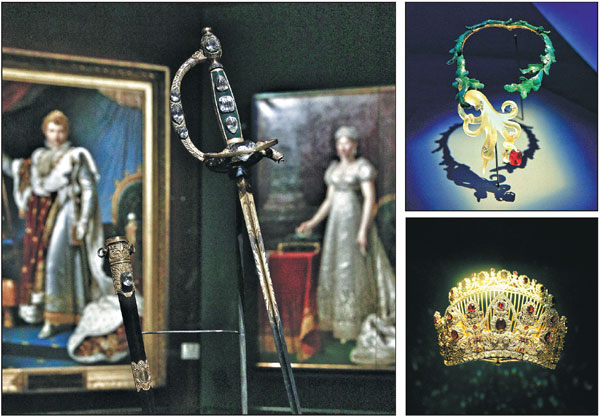French treasures
By Wang Kaihao (China Daily) Updated: 2017-04-11 07:59An exhibition of precious objects from France, including a dazzling sword carried by Napoleon Bonaparte at his coronation, is set to open at the Palace Museum in Beijing. Wang Kaihao reports.
At Napoleon Bonaparte's coronation at the Notre-Dame de Paris on Dec 2, 1804, he carried a sword adorned with a 140-carat diamond that was previously set on the coronation crown of Louis XV and Louis XVI, and 42 other gemstones from France's national treasures.
The Consular Sword - a national treasure itself - now with the Chateau de Fontainebleau,will be on display at the Palace Museum in Beijing, also known as the Forbidden City, from Tuesday. It will be the first time it has left the country.
The sword, which will be featured at the Imperial Splendours: The Art of Jewelry since the 18th Century exhibition,will be part of a display of nearly 300 other precious objects at the Meridian Gate Gallery.
|
A collection of French treasures, including the Consular Sword (above left), will be part of a display of nearly 300 precious objects at the Palace Museum in Beijing from Tuesday. Photos by Jiang Dong / China Daily |
According to Karine Hugenaud, deputy director of the museum affiliated with Chaumet, the French high-end jewelry maker behind the exhibits, the oldest item on display is a gold box decorated with shells and cloisonne enamel.
Made in 1789, it is the earliest surviving work of jeweler Marie-Etienne Nitot, the founder of Chaumet.
"The exhibits are closely connected with history, and show the influence of many art schools, ranging from classicalism to Art Deco," she says.
A malachite cameo parure belonging to Empress Josephine, and a daywear parure with micro-mosaics belonging to Empress Marie-Louise represent Napoleon's two marriages.
A parure typically consists of a combination of a matching necklace, earrings, brooch, bracelet and often a diadem or tiara.
According to Hugenaud, there are more than 20 tiaras on display, created over a period of nearly two centuries. Nature is a key theme in the works, especially in the hair ornaments and brooches.
"The jewelers' creations express a highly sensitive interpretation of the beauty of flowers, fruit and foliage," she says.
"Nature is a mirror that reflects human sentiment and emotion."
According to Jean-Marc Mansvelt, CEO of Chaumet, it took four years to prepare for the exhibition.
The exhibits were chosen from 17 museums including the Louvre Museum, the Chateau de Fontainebleau and the Victoria and Albert Museum in London.Approval had to be sought from the French government for artifacts like the Consular Sword to be sent abroad.
"The exhibition is about 250 years of creation. And this place (the Palace Museum) is about eternity, and everyone knows it," Mansvelt says while explaining why the top-tier pieces were brought to Beijing.
"There is a link. It's about a cultural exchange between France and China."
Meanwhile, the exhibition is also displaying 20 items from the imperial families of the Qing Dynasty (1644-1911), which is housed by the Palace Museum
Meanwhile, the Palace Museum is also displaying more than 20 items
Zhang Xin, a researcher at the Palace Museum, says: "What we have this time are not the most exquisite pieces. But they are the most interesting ones for this exhibition."
Among the items on show are a pair of teapots: a French one from mid-19th century inspired by Chinese architectural elements, and a Chinese one painted with enamel in a typical Western style.
There are also some French vanity cases decorated with Chinese motifs and typically Chinese ones at the exhibition, in a bid to show both contrast and similarity.
Zhang says: "France represented high-end fashion in the 19th century, but it was also greatly influenced by Chinese art at that time. And using jade and emerald in art pieces was a popular trend."
Zhang also says that Chinese fans were an indispensable accessory for ladies in France at that time, though they were mainly used by male literati in China then.
A fan depicting an ancient Chinese war scene belonging to a marquise is also on display.
Sadly, the exhibition will not go to other Chinese cities, and Mansvelt jokes that "maybe you will have to wait for another 200 years to see Napoleon's sword travel out of France".
But, he adds that more exhibitions of Chaumet jewelry are likely to be held in China.
"The possibilities are enormous," Mansvelt says."If other (Chinese) museums or art galleries are interested, we are interested.
"But we want to do something different."
Contact the writer at wangkaihao@chinadaily.com.cn
- 'Cooperation is complementary'
- Worldwide manhunt nets 50th fugitive
- China-Japan meet seeks cooperation
- Agency ensuring natural gas supply
- Global manhunt sees China catch its 50th fugitive
- Call for 'Red Boat Spirit' a noble goal, official says
- China 'open to world' of foreign talent
- Free trade studies agreed on as Li meets with Canadian PM Trudeau
- Emojis on austerity rules from top anti-graft authority go viral
- Xi: All aboard internet express












